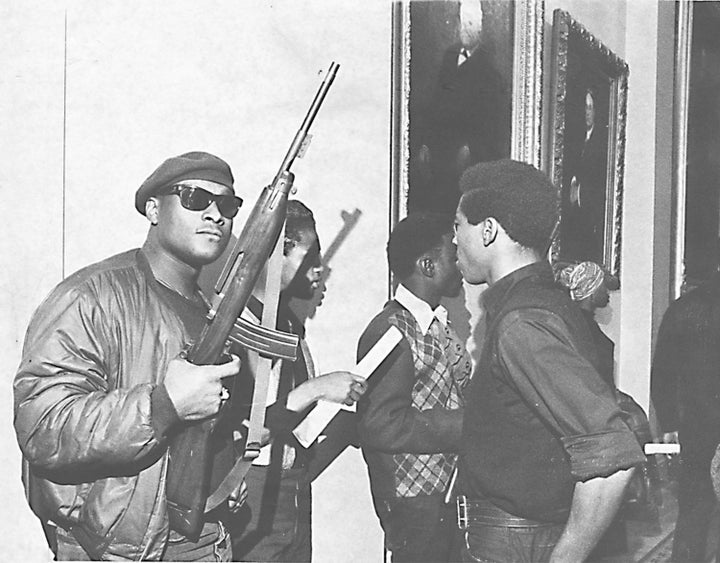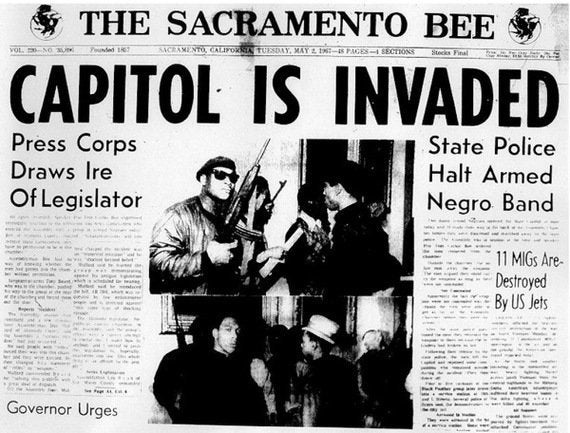When armed militants seized a government building in Burns, Oregon, on Saturday, stating their willingness to "kill and be killed" and promising to stay for "years," the official response was cautious and restrained. Many onlookers wondered whether this would still be the case if the militants were people of color instead of white people.
If you're not familiar with the history of protest in the U.S., you might not know that the armed occupation of government buildings hasn't always been just for white guys. In fact, on May 2, 1967, a group of 30 Black Panthers walked into the California state Capitol building, toting rifles and shotguns and quickly garnering national headlines.
Just to be clear, there are a world of differences between the Black Panthers' demonstration and what's happening in Oregon now (although it is noteworthy that you have to go back to 1967 to find an example of black activists doing something even remotely analogous). The two groups employed different tactics, fought for different causes and -- predictably -- elicited different reactions in vastly different places and times. But the 1967 incident serves as one example of the way Americans tend to respond to black protest -- which some say is always likely to be different from the way Americans react when it's white people doing the protesting.

In October 1966, Huey P. Newton and Bobby Seale formed the Black Panther Party for Self Defense as a small community organization based in Oakland, California. Its members -- including the 30 people who would travel to Sacramento the following May -- believed that black Americans should exercise their constitutional right to defend themselves against an oppressive U.S. government. At the time, California lawmakers were trying to strip them of that right, and the Black Panthers wanted to tell the U.S., and the world, that they found this unacceptable.
Among other things, the Black Panthers' agenda involved taking up arms and patrolling their communities to protect against rampant racism in policing. And that's what they did in the first few months of the party's existence, carrying guns openly in compliance with California law, driving around their neighborhoods, observing arrests and other law enforcement activity -- effectively policing the police. Newton was even known for packing a law book alongside his rifle that he'd recite from when informing an officer that a civilian's rights were being violated.
The patrols weren't meant to encourage violence. The Panthers were committed to using force only if it was used against them, and at first, their mere presence appeared to be working as a check on abusive policing. But the Panthers' willful assertion of their rights -- like the day Newton reportedly stood up to a cop in front of a crowd of black onlookers -- was unacceptable to white authority figures who'd come to expect complete deference from black communities, and who were happy to use fear and force to extract it.
Don Mulford, a GOP assemblyman who represented Oakland, responded to the Black Panther police patrols in 1967 with a bill to strip Californians of the right to openly carry firearms.
Nobody tried to stop the 30 Black Panthers -- 24 men and six women, carrying rifles, shotguns and revolvers -- as they walked through the doors of the state Capitol building on May 2 of that year. This was decades before Sept. 11 or the Oklahoma City bombing, and the protesters were, after all, legally allowed to have their weapons. They entered with their guns pointed at the ceiling. Behind them followed a horde of journalists they'd called to document the protest.
As the rest of the group waited nearby, six Panthers entered the assembly chamber, where they found lawmakers mid-session. Some legislators reportedly saw the protesters and took cover under desks. It was the last straw: Police finally ordered the protesters to leave the premises. The group maintained they were within their rights to be in the Capitol with their guns, but eventually they exited peacefully.
Outside, Seale delivered the Black Panther executive mandate before a crush of reporters. This section of remarks, reprinted in Hugh Pearson's The Shadow of the Panther, still resonates today:
"Black people have begged, prayed, petitioned, demonstrated, and everything else to get the racist power structure of America to right the wrongs which have historically been perpetuated against black people. All of these efforts have been answered by more repression, deceit and hypocrisy. As the aggression of the racist American government escalates in Vietnam, the police agencies of America escalate the oppression of black people throughout the ghettoes of America. Vicious police dogs, cattle prods, and increased patrols have become familiar sights in black communities. City Hall turns a deaf ear to the pleas of black people for relief from this increasing terror."
Shortly after Seale finished, police arrested the group on felony charges of conspiracy to disrupt a legislative session. Seale accused them of manufacturing "trumped up charges," but the protesters would later plead guilty to lesser misdemeanors.
Mulford's legislation, which became known as the "Panthers Bill," passed with the support of the National Rifle Association, which apparently believed that the whole "good guy with a gun" thing didn't apply to black people. California Gov. Ronald Reagan (R), who would later campaign for president as a steadfast defender of the Second Amendment, signed the bill into law.
Although the May 2 demonstration failed to sway lawmakers into voting against the Mulford Act -- and may have even convinced some of them that such a measure was necessary -- it did succeed in making the Black Panthers front-page news. Headlines ran above evocative photos of armed black protesters, many wearing berets, bomber jackets and dark sunglasses, walking the halls of the California Capitol. And the American public's response to that imagery reflected a nation deeply divided on the issue of race.
On one hand, such a defiant demonstration of black power served as recruitment fodder for the Black Panther Party, which had previously only been operating in the Bay Area. It grew in size and influence, opening branches in a number of major cities, building a presence on college campuses and ultimately surging to as many as 5,000 members across 49 local chapters in 1969.
The party even attracted a number of radical-leaning white supporters -- many of whom were moved by the Black Panthers' lesser-remembered efforts, like free breakfasts for children in black neighborhoods, drug and alcohol abuse awareness courses, community health and consumer classes and a variety of other programs focused on the health and wellness of their communities.
But it was clear from the moment the Black Panthers stepped inside the California Capitol that the nuances of the protest, and of Seale's message, weren't going to be understood by much of white America. The local media's initial portrayal of the brief occupation as an "invasion" would lay the groundwork for the enduring narrative of the Black Panthers first and foremost as a militant anti-white movement.

In August 1967, FBI Director J. Edgar Hoover took steps to ensure that public support for the Black Panthers would remain marginal. In a memorandum just months after the armed protest, he deemed the group a "black nationalist, hate-type organization" to be neutralized by COINTELPRO, a controversial initiative that notoriously skirted the law in its attempts to subvert any movement that Hoover saw as a potential source of civil disorder. A 2012 report further uncovered the extent of the agency's activity, revealing that an FBI informant had actually provided the Black Panthers with weapons and training as early as 1967.
As the Panthers' profile grew in the months and years following the California Capitol protest, so too did their troubles -- something that many of the Panthers themselves regarded as no coincidence. Just two months after Hoover put the Black Panthers in his sights, Newton was arrested and convicted of killing Oakland police officer John Frey, a hotly contested development and the first in a series of major, nationwide controversies that engulfed the movement. (Newton ultimately served two years of his sentence before his conviction was overturned in a set of appeals.)
The strength of the Black Panthers ebbed and flowed in the years leading up to the organization's dissolution in 1982. The party struggled to find a balance between its well-intentioned community efforts and its reliance on firepower and occasional violence to bolster its hardened image. High-profile shootouts with police and arrests of members created further rifts in the group's leadership and helped cement the white establishment's depiction of Black Panthers as extremists.
Many white Americans couldn't get over their first impression of the Black Panthers. Coverage of the 1967 protest introduced them to the party, and the fear of black people exercising their rights in an empowered, intimidating fashion left its mark. To them, the Black Panthers were little more than a group of thugs unified behind militaristic trappings and a leftist political ideology. And to be fair, some members of the party were criminals not just in the minds of frightened white people.
The Black Panther protest in 1967 is not the "black version" of what's happening in Oregon right now. Those demonstrators entered the state Capitol lawfully, lodged their complaints against a piece of racially motivated legislation and then left without incident. But for those who see racial double standards at play in Oregon, the scope and severity of the 1967 response -- the way the Panthers' demonstration brought about panicked headlines, a prolonged FBI sabotage effort and support for gun control from the NRA, of all groups -- will serve as confirmation that race shapes the way the country reacts to protest.
This article has been updated to specify that one has to go as far back as 1967 to find black activists -- rather than any activists of color at all -- participating in a protest similar to the Oregon occupation.
Also on HuffPost:
